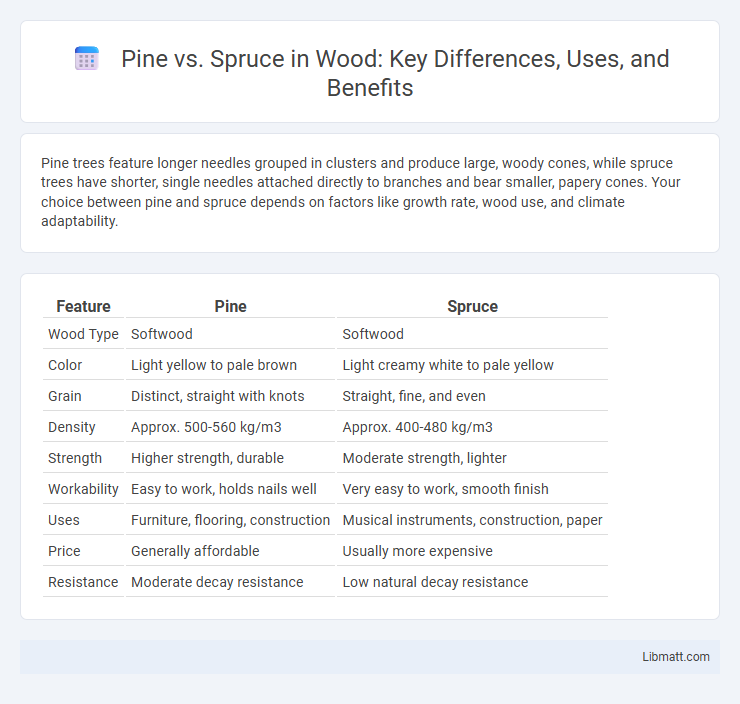Pine trees feature longer needles grouped in clusters and produce large, woody cones, while spruce trees have shorter, single needles attached directly to branches and bear smaller, papery cones. Your choice between pine and spruce depends on factors like growth rate, wood use, and climate adaptability.
Table of Comparison
| Feature | Pine | Spruce |
|---|---|---|
| Wood Type | Softwood | Softwood |
| Color | Light yellow to pale brown | Light creamy white to pale yellow |
| Grain | Distinct, straight with knots | Straight, fine, and even |
| Density | Approx. 500-560 kg/m3 | Approx. 400-480 kg/m3 |
| Strength | Higher strength, durable | Moderate strength, lighter |
| Workability | Easy to work, holds nails well | Very easy to work, smooth finish |
| Uses | Furniture, flooring, construction | Musical instruments, construction, paper |
| Price | Generally affordable | Usually more expensive |
| Resistance | Moderate decay resistance | Low natural decay resistance |
Introduction to Pine and Spruce
Pine and spruce are two distinct types of coniferous trees commonly used in construction, furniture, and paper production due to their unique wood characteristics. Pine features softer wood with a more pronounced grain and higher resin content, making it easier to work with but more susceptible to dents. Spruce wood is lighter, with a finer, straighter grain and better strength-to-weight ratio, ideal for musical instruments and structural applications where durability is crucial for your projects.
Botanical Differences
Pine trees belong to the genus Pinus and feature needles grouped in clusters of two to five, while spruce trees, from the genus Picea, have single needles attached directly to branches on woody pegs. Pines typically exhibit longer, softer needles that are flexible, contrasted with spruce's shorter, stiffer needles that have a square cross-section and are sharp to the touch. Understanding these botanical differences can help you accurately identify and select the right conifer for your landscaping or woodworking needs.
Wood Grain and Appearance
Pine wood features a straight grain with a more prominent, wider grain pattern and a lighter yellowish or pale color, often displaying knots that add character to your projects. Spruce has a finer, tighter grain with a more uniform texture and a pale white to creamy color, giving a cleaner and smoother appearance ideal for musical instruments or detailed woodworking. Both woods offer distinct aesthetic qualities, but your choice depends on whether you prefer the rustic charm of pine or the refined look of spruce.
Strength and Durability
Pine wood offers moderate strength and durability, making it suitable for indoor furniture and construction with protective treatments. Spruce wood, known for its high strength-to-weight ratio and resilience, is widely used in structural applications such as framing and musical instruments. Its superior resistance to wear and decay enhances longevity compared to pine, especially in outdoor or load-bearing contexts.
Common Uses and Applications
Pine is widely used in construction, furniture making, and paper production due to its softness and ease of working, making it ideal for interior finishes and cabinetry. Spruce is favored in musical instruments like guitars and violins for its superior resonant qualities, as well as in structural applications such as framing and flooring because of its strength-to-weight ratio. Both woods serve essential roles in the lumber industry but are chosen based on specific performance characteristics related to their grain, density, and flexibility.
Workability and Handling
Pine wood offers excellent workability due to its soft texture and straight grain, making it easy to cut, shape, and fasten for both beginners and professionals. Spruce, while also relatively soft, has a slightly finer grain that provides a smoother finish but can be more prone to dents during handling. Your choice between pine and spruce will depend on the specific project, with pine being more forgiving for complex cuts and spruce favored for a cleaner surface appearance.
Cost Comparison
Pine wood generally costs less than spruce due to its faster growth rate and wider availability, making it a budget-friendly option for construction and furniture projects. Spruce is typically more expensive because of its superior strength-to-weight ratio and finer grain, which is preferred for musical instruments and specialty woodworking. Pricing varies regionally, but pine remains the economical choice for large-scale uses while spruce commands a premium for quality-driven applications.
Environmental Impact
Pine trees generally have a lower environmental impact due to their rapid growth and ability to thrive in diverse soil conditions, which supports reforestation efforts effectively. Spruce trees, while slower growing, play a crucial role in carbon sequestration and provide essential habitats for numerous wildlife species. Your choice between pine and spruce should consider factors like local ecosystem compatibility and the sustainability of harvesting practices to minimize environmental disruption.
Maintenance and Longevity
Pine requires more frequent maintenance due to its softer wood, which is prone to dents and scratches, and it typically needs regular sealing or staining to protect against moisture and insect damage. Spruce offers greater longevity with its denser and more durable wood, making it more resistant to decay and less likely to warp over time when properly treated. Both woods benefit from routine inspections and treatments, but spruce generally demands less intensive upkeep, increasing its lifespan in construction and outdoor applications.
Choosing Between Pine and Spruce
Choosing between pine and spruce depends on the intended use, as pine wood is denser, more durable, and offers better resistance to decay, making it ideal for furniture and flooring. Spruce wood is lighter, has a fine, even texture, and is commonly used for construction, musical instruments, and paper production due to its excellent strength-to-weight ratio. Evaluating factors such as workability, aesthetic preferences, and environmental exposure helps guide the selection between pine and spruce for specific projects.
Pine vs Spruce Infographic

 libmatt.com
libmatt.com